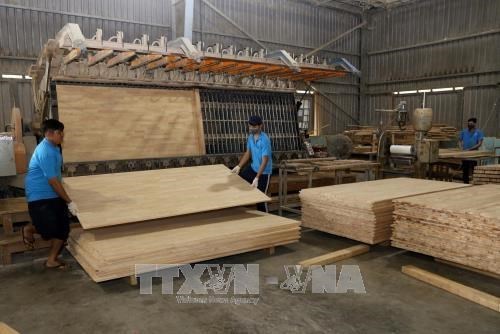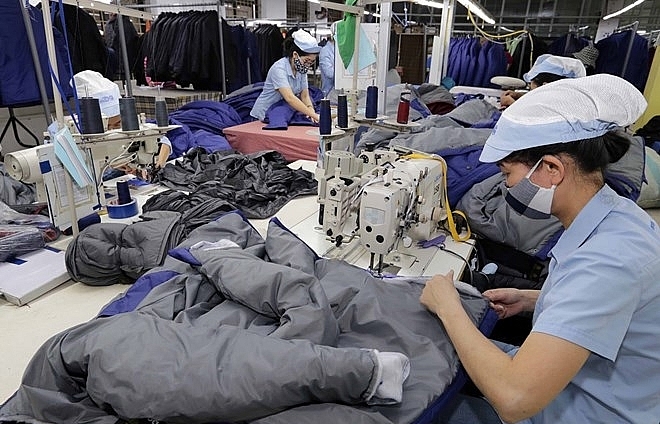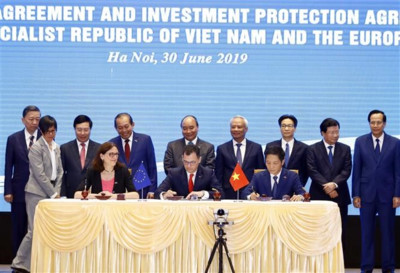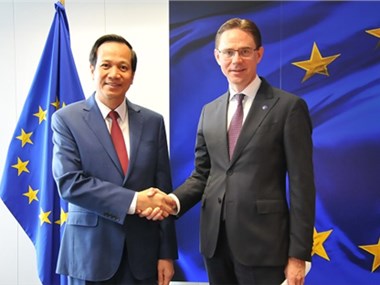- © Copyright of Vietnamnet Global.
- Tel: 024 3772 7988 Fax: (024) 37722734
- Email: evnn@vietnamnet.vn
evfta
Update news evfta
Textile and garment industry sees great opportunities in EVFTA
 A number of industries that make products for export, including textiles and garments, are expected to change for the better if they can take full advantage of the value chain from EVFTA.
A number of industries that make products for export, including textiles and garments, are expected to change for the better if they can take full advantage of the value chain from EVFTA.
Garment and footwear to be greatly beneficial from EVFTA
 With tax barriers for less sensitive commodities being completely lifted within no later than three years since the adoption of the or EVFTA, Vietnam’s garment and footwear industries are predicted to be beneficial from the trade deal.
With tax barriers for less sensitive commodities being completely lifted within no later than three years since the adoption of the or EVFTA, Vietnam’s garment and footwear industries are predicted to be beneficial from the trade deal.
EVFTA to sustainably boost Vietnam’s wood exports to EU
 Vietnam and the European Union (EU) last week signed a landmark free trade deal that will slash tariffs on almost all goods, including wood and timber products.
Vietnam and the European Union (EU) last week signed a landmark free trade deal that will slash tariffs on almost all goods, including wood and timber products.
Apparel sector urged to develop supporting industry to optimise EVFTA
 Insiders have recommended Vietnam pay attention to developing weaving and other production activities supporting the textile-garment sector to make best use of the EVFTA, a freshly-inked free trade agreement with the EU.
Insiders have recommended Vietnam pay attention to developing weaving and other production activities supporting the textile-garment sector to make best use of the EVFTA, a freshly-inked free trade agreement with the EU.
Local firms need to improve capacity when joining EVFTA
 Improving corporate governance capacity is a major challenge for businesses, especially small-and-medium sized enterprises when joining the EVFTA, requiring the Government to have policies and mechanisms to facilitate their operation.
Improving corporate governance capacity is a major challenge for businesses, especially small-and-medium sized enterprises when joining the EVFTA, requiring the Government to have policies and mechanisms to facilitate their operation.
Top legislator, EU trade commissioner talk about EVFTA
 Chairwoman of the National Assembly Nguyen Thi Kim Ngan and European Commissioner for Trade Cecilia Malmstrom exchanged ideas related to the signing and ratification of the EU-Viet Nam Free Trade Agreement (EVFTA)
Chairwoman of the National Assembly Nguyen Thi Kim Ngan and European Commissioner for Trade Cecilia Malmstrom exchanged ideas related to the signing and ratification of the EU-Viet Nam Free Trade Agreement (EVFTA)
PM Nguyen Xuan Phuc witnesses signing of Vietnam-EU FTA, IPA in Hanoi
 Prime Minister Nguyen Xuan Phuc witnessed the signing of the Vietnam-EU Free Trade Agreement and the Investment Protection Agreement in Hanoi on June 30.
Prime Minister Nguyen Xuan Phuc witnessed the signing of the Vietnam-EU Free Trade Agreement and the Investment Protection Agreement in Hanoi on June 30.
EVFTA and CPTPP expected to help Japan become Vietnam’s No.1 investor again
 Japanese companies with abundant expertise in many fields such as banking, insurance, construction, logistics, accounting, graphic design, among others, are expected to have greater opportunities in Vietnam’s market.
Japanese companies with abundant expertise in many fields such as banking, insurance, construction, logistics, accounting, graphic design, among others, are expected to have greater opportunities in Vietnam’s market.
Vietnam, EU to sign EVFTA on June 30 in Hanoi
 The European Council announced on June 25 that it has approved the EVFTA and the EU – Vietnam Investment Protection Agreement (EVIPA), and assigned the EU to sign the deals with Vietnam on June 30 in Hanoi.
The European Council announced on June 25 that it has approved the EVFTA and the EU – Vietnam Investment Protection Agreement (EVIPA), and assigned the EU to sign the deals with Vietnam on June 30 in Hanoi.
Vietnam’s agricultural sector to face fierce competition
 Local firms are set to face fierce competition from EU imports thanks to two upcoming agreements between the two sides.
Local firms are set to face fierce competition from EU imports thanks to two upcoming agreements between the two sides.
Vietnam reasserts to realise int’l commitments on labour
 Minister of Labour, Invalids and Social Affairs Dao Ngoc Dung paid a working visit to the EU and Belgium on June 20-21 to speed up the signing of the EU-Vietnam free trade agreement.
Minister of Labour, Invalids and Social Affairs Dao Ngoc Dung paid a working visit to the EU and Belgium on June 20-21 to speed up the signing of the EU-Vietnam free trade agreement.
Towards plastic alternatives in Vietnam
 New opportunities will come to plastic and packaging producers in Vietnam ready to change their business strategies.
New opportunities will come to plastic and packaging producers in Vietnam ready to change their business strategies.
Vietnam’s 6 sectors projected for breakthroughs in investment in 2019
 These sectors include two emerging sectors in the form of fintech and e-commerce, and four traditional sectors, including education, green energy, healthcare & pharmaceuticals, transportation & logistics.
These sectors include two emerging sectors in the form of fintech and e-commerce, and four traditional sectors, including education, green energy, healthcare & pharmaceuticals, transportation & logistics.
M&A in Vietnam’s retail industry on the rise in 2019
Retail is attractive for investors as the industry has advantages after foreign wholly-owned retail firms have been allowed to set up in Vietnam and taxes imposed on most of goods imported from other ASEAN countries to Vietnam are exempted.
EVFTA, Industry 4.0 critical to Vietnam’s next development phase
The EU-Vietnam Free Trade Agreement (EVFTA) and Industry 4.0 are two significant factors that should be utilized to help guarantee success in the next phase of Vietnam’s development, heard a conference held in Hanoi on March 14.
Deputy PM: Vietnam treasures strategic partnership with Germany
VietNamNet Bridge – Deputy Prime Minister and Foreign Minister Pham Binh Minh has affirmed that Vietnam treasures its strategic partnership with Germany - a leading partner of Vietnam in Europe.
Vietnam sees new investment wave from Europe
VietNamNet Bridge - Investment and goods flowing from Europe to Vietnam have increased greatly as the EU-Vietnam FTA will take effect next year.
PM expects removal of EC’s warning on seafood
VietNamNet Bridge – Vietnam is striving to have the European Commission’s ‘yellow card’ warning on Vietnamese seafood removed, said Prime Minister Nguyen Xuan Phuc.
US trade war with China to strengthen Vietnam’s competitiveness
Vietnam has free trade agreements with Canada, Japan and Mexico (through CPTPP), and plans to sign an FTA with the EU. These will be advantages in the US - China trade war.
Vietnam’s textile & garment industry expect big benefits from EVFTA
VietNamNet Bridge - Once the EU-Vietnam FTA (EVFTA) is signed and the tariff is cut to zero percent, textile and garment exports to the market may obtain 7-8 percent growth rate per annum, experts say.



















